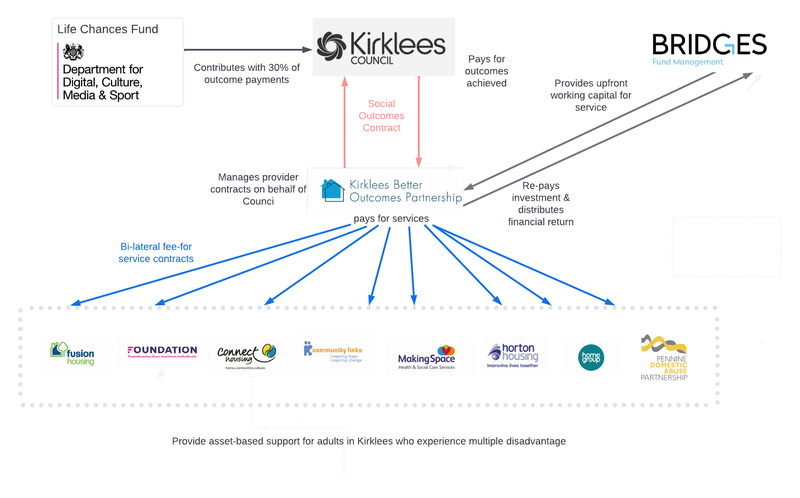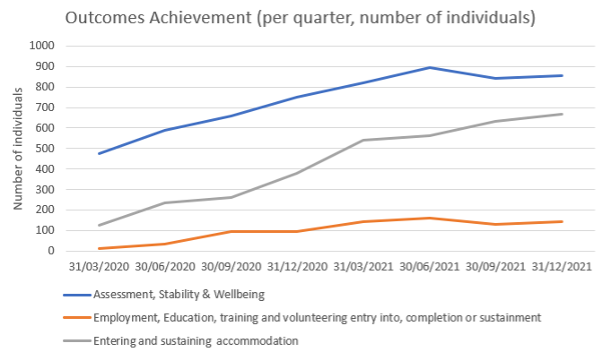
- Impact bond
- Homelessness
- Health and wellbeing
- Employment and training
- UK
Kirklees, West Yorkshire, United Kingdom
6 mins
Kirklees Better Outcomes Partnership (KBOP)
Last updated: 3 Aug 2022
- Kirklees Better Outcomes Partnership (KBOP)
- SDGs and project locations
- INDIGO Key facts and figures
- Target population
- The problem
- The solution
- The impact
- Outcomes Framework
- Project insights
- Kirklees Better Outcomes Partnership (KBOP)
- SDGs and project locations
- INDIGO Key facts and figures
- Target population
- The problem
- The solution
- The impact
- Outcomes Framework
- Project insights
The Kirklees Better Outcomes Partnership (KBOP) impact bond aims to secure better outcomes for disadvantaged Kirklees residents. This project is funded by the UK Government Department for Digital, Culture, Media and Sport's (DCMS) Life Chances Fund (LCF) and by Kirklees Council.
Project Location
INDIGO Key facts and figures
-
INDIGO project
-
Commissioner
-
Intermediary
-
Investor
-
Provider
-
Funds
-
Launch date
October 2019
-
Start of service provision
September 2019
-
Duration
5 years
-
Capital raised (minimum)
GBP 3.47m
(USD 4.43m)
-
Service users
6k+
Target population
The cohort will be people over the age of 16 who have vulnerabilities and support needs that may impact on their ability to live independently and who may, without support, be at increased risk of homelessness due to their disabilities, vulnerabilities, issues or lifestyle factors that increase this risk. They are, for example, people who are homeless, at risk of becoming homeless or with a history of repeat homelessness, offenders, people with mental health problems, learning disabilities, those that abuse substances, those at risk of domestic abuse, care leavers or young people at risk including young parents, refugees.
The problem
In Kirklees the provision of services for adults with housing-related support needs has previously been commissioned as a housing Floating Support service under the umbrella of the Supporting People programme. The service was expected to function as a preventative service and aimed to help people to sustain independent living and avoid tenancy issues. Although this was a valued service, an interim evaluation report from the Government Outcomes Lab finds that the legacy service was fragmented and faced significant challenges. These included short-term contracts, limited contract and performance management, limited flexibility in service delivery, and limited collaboration across service providers.
The solution
The KBOP SIB responds to these challenges by remodelling the delivery of services under a single outcomes contract with the involvement of a new coordinating organisation ‘KBOP’.
There are two key paths through which this is expected to improve the service and outcomes for participants. At the frontline, the flexibility of the outcomes-contract is hoped to bring greater person-centredness and tailored support. This responsive, asset-based approach is coupled with strong performance management.
The objective of the project is to produce better outcomes for disadvantaged Kirklees residents. It will do this by providing preventative support to people aged 16+ who have vulnerabilities or support needs that may impact on their ability to live independently. Supporting people to find and maintain suitable accommodation will have a positive impact on other areas of participants’ lives, including health and wellbeing, access to work & learning, reductions in domestic violence, offending behaviour and substance misuse. Early intervention reduces the demand for higher cost crisis and long-term interventions.
The key outcomes are to support people to access and maintain suitable, safe accommodation; to maintain stability and wellbeing, and to access employment & learning. Everyone who meets the threshold to access the service via an objective referral and triage system will receive support to access and maintain accommodation.
KBOP aims to respond to participant aspirations using an asset-based approach. Many participants will be supported to enter or take steps towards employment. Participants who experience a range of challenges (including repeat offending behaviour; domestic violence, substance misuse and enduring mental health problems) or who struggle to maintain work will be supported to achieve stability and maintain their independence and wellbeing.
At a system-level KBOP is expected to facilitate coordination by shaping service pathways, supporting service providers and providing collaborative infrastructure so that delivery organisations work together for the same goals.
KBOP Governance

The Kirklees Better Outcomes Partnership (KBOP) SIB re-models the delivery of the Floating Support services under a single outcomes contract. The service is delivered by the same voluntary sector organisations that were involved in the provision of the pre-SIB Floating Support service. However, one provider organisations dropped out of SIB service delivery after nine months based on mutual agreement.
The impact
Preliminary outcome analysis of the outcomes achievements from March 2020 to December 2021 suggests that achievements are consistently above pre-defined ambitions. The service is most successful in achieving assessment, stability and wellbeing outcomes. Despite a structural challenge related to limited housing availability, the service succeeded in increasing its performance in accommodation outcomes. To date, the least successful area is for education, training and employment outcomes. The impacts of Covid-19 on the labour market severely affect ETE outcomes and services to facilitate employment is still a relatively new dimension for providers to develop.

"The focus on individual outcomes and what matters most to the beneficiary is proving to have great results and is making a big difference to many people’s lives"
- Emma Hanley, Senior Contracting and Procurement Manager at Kirklees Council
Outcomes Framework
| Long-term improvement for service user | Outcomes |
|---|---|
| Wellbeing | 1st Wellbeing assessment |
| 2nd Wellbeing assessment | |
| 3rd Wellbeing assessment | |
| Wellbeing improvement - 1st to 2nd assessment | |
| Wellbeing improvement - 1st to 3rd assessment | |
| Managing Money | Financial resilience outcomes |
| Emotional & Mental Health | Accessing services |
| Drug & Alcohol Misuse | Mental health sustained engagement with services |
| Drugs/alcohol sustained engagement with services | |
| Accommodation | Prevention/relief/entry into suitable accommodation |
| 3 months accommodation outcomes | |
| 6 months accommodation outcomes | |
| 12 months accommodation outcomes | |
| 18 months accommodation outcomes | |
| Education, training & employment (ETE) | Entry into education and employment |
| Part completion of Ofqual approved qualification | |
| Completion of full Ofqual approved qualification | |
| Entry into employment | |
| 6.5 week equivalent employment F/T | |
| 13 weeks equivalent employment F/T | |
| 26 weeks equivalent employment F/T | |
| Entry into volunteering | |
| 6 weeks volunteering | |
| Prevention of domestic abuse | Reduction in risk of domestic abuse |
| Accessing rights to legal protection | |
| Empowering and promoting independence |
Project insights
Multi-year funding & introduction of a social prime
Prior to the SIB, the service experienced significant budget reductions and contracts were awarded on a short-term basis. The Council team was severely constrained and limited resource was available for shaping services or contract management. Providers indicated that the legacy arrangements struggled to address long-term outcomes.
The multi-year outcomes contract enables participants to pursue longer-term outcomes, most notably education, training and employment (ETE) outcomes. In a pioneering approach, this outcomes contract incorporates learning and adjustment of the outcome measure design (i.e., a flexible rate card) as well as adaptive service delivery. On the flipside, the adaptive nature of the outcomes contract has meant that providers must navigate changes to their operational processes, diminishing providers’ sense of stability associated with the funding security.
A key innovation in the governance of the service is the introduction of a social prime (KBOP) replacing Kirklees Council in its provider contract monitoring role. The social prime brings a dedicated team funded by the social investor, whose sole responsibility is the management of the SIB service. The social prime brings more frequent and tighter performance monitoring; specifically, KBOP supports providers’ data collection and reporting obligations through an impact analyst. While the enhanced performance monitoring is more resource intensive for providers, delivery teams recognise the benefit of being able to swiftly ‘course-correct’ and test service innovations.
Co-designed outcome measures & transparent measurement
Historically, the Key Performance Indicators focused on evidencing user numbers and throughput of service users rather than understanding long-term outcomes. Moreover, the ‘independent living’ KPI lacked clear, well-defined measures of success, allowing considerable provider discretion in determining the ‘success’ of the intervention’.
The design of the outcomes framework features an iterative approach which incorporates learning and improves responsiveness to service participants’ needs. Importantly, the iterative approach was built into the contract and follows a pre-defined procedure. The process was highly collaborative and ensures that the indicators of performance are meaningful for service delivery at a person level.
Alongside clear outcome definitions, the inclusion of education, training and employment (ETE) outcomes is the most significant change in service objectives. While providers’ views on the appropriateness of these outcomes for the cohort was mixed, research findings suggest that inclusion increased support workers’ awareness of considering long-term ETE outcomes much earlier in the participant’s support journey.
A central shared data management system facilitates independent validation of the outcomes by Kirklees Council and tracks the sustainment of outcomes over time. A key benefit is enhanced transparency and insights though a drawback is the increased administrative burden for providers.
Streamlined referral process
Participants were having to tell their story multiple times as the service lacked a coordinated approach to referrals and there was no shared case management system. There was limited transparency on the demand for, and performance of services offered by different providers. This resulted in service users sitting on multiple waiting lists, leading to delays in referral allocations and a limited visibility of service users who were re-entering the system.
A streamlined referral process is enabled by a central intelligence system and by the social prime acting as a central referral hub. Referrals to the service can come from a diverse array of local teams, including Councillors and self-referral. Providers no longer handle referrals directly. The coordination of this process means that participants are no longer sitting on multiple waiting lists. Framing the referral process as an asset-based conversation is intended to overcome known issues with a ‘deficit’ model. A single point of contact is also expected to improve the visibility and accessibility of the service and the managed allocation process negates competition for referrals between providers.
Enhanced flexibility in service delivery
Under the old fee-for service contracts, there were tight specifications on service intensity and length. The service specification was seen to prevent the adoption of more innovative, personalised approaches, and impeded the ability to address service gaps.
Under the SIB, service providers describe greater implementation autonomy fostering the personalisation of services. Frontline staff have discretion in determining - in agreement with the participant - the type of support, i.e. virtual or face-to-face, and the frequency of support. Likewise, providers are granted autonomy in piloting new interventions and creating new staff roles which allow the service to be more responsive to participants. A key facilitator for enhanced flexibility is the personalisation fund which provides additional funding to support service delivery. The immediate availability of funding was seen in stark contrast to the bureaucratic and lengthy process in the resource-constrained public sector where funding – even for small additional items – can be challenging to access.
Dedicated resources for collaboration and shared outcomes focus
Previously, the scarce contract management function of the Council limited the ability to establish an infrastructure for collaborative working between providers. Moreover, the requirement to evidence ‘service utilisation’ was understood to fuel competition for referrals between providers.
Collaboration across providers increased under the SIB commissioning arrangement. Resources and best practices are shared across providers. Vital for building a collaborative infrastructure has been the facilitation and coordination role of the social prime. In addition to having a dedicated resource, the multi-year funding allows stakeholders to build trusting relationships. Unlike the preceding fee-for service contract, providers no longer need to compete for resources to deliver the service. However, it is important to note that providers still compete for contracts beyond the SIB. Emergent evidence indicates that the goal alignment through shared outcomes fosters a sense of commitment and collaboration across providers.
Contact details
Emma Hanley
Senior Contracting and Procurement Manager, Kirklees Council
This case study was compiled by Franziska Rosenbach with support from Eleanor Carter and Fernando Domingos.
Last updated: June 2022